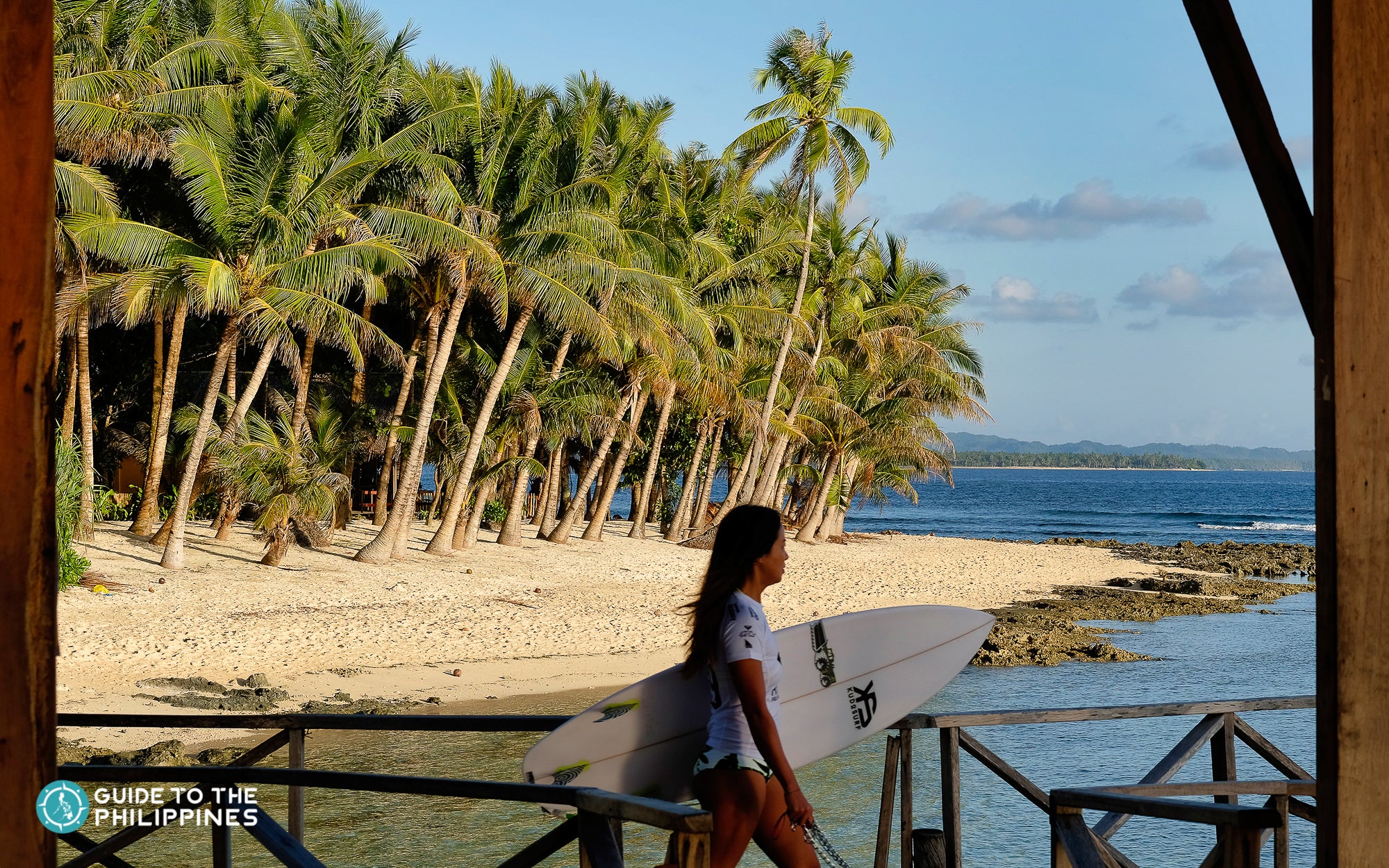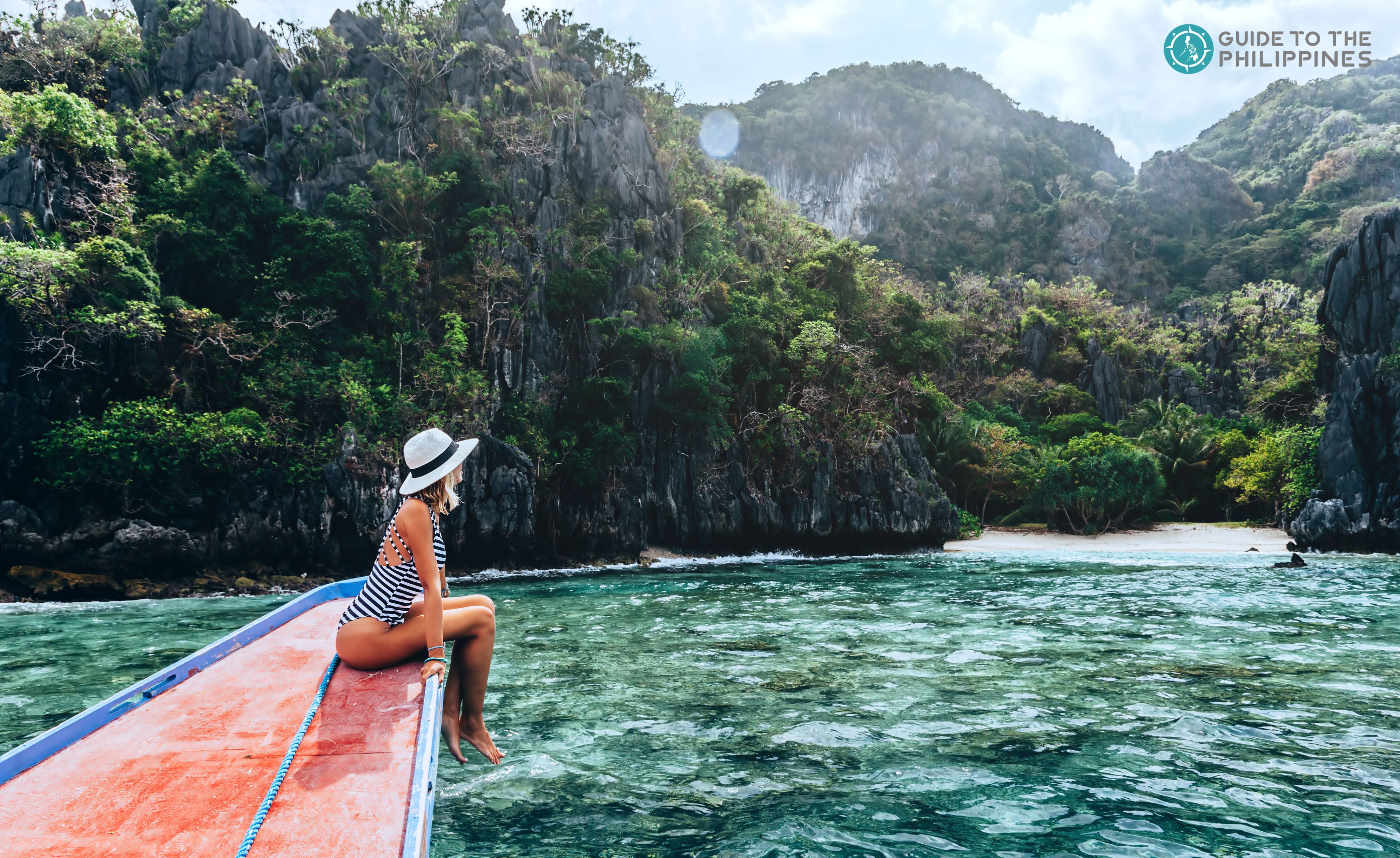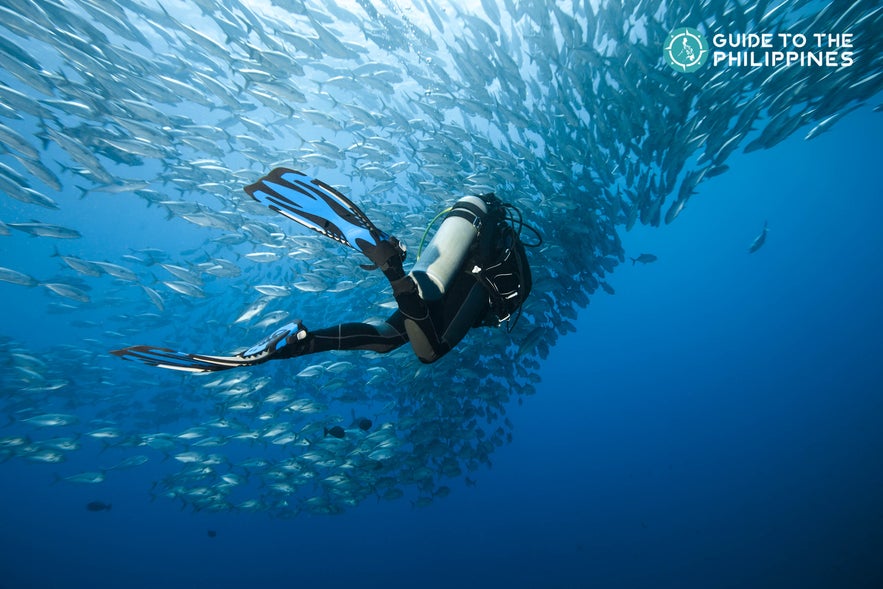
Get ready to explore some of the top diving spots in the Philippines, from UNESCO-listed reefs to rare encounters with thresher sharks and sea turtles. You’ll swim through thriving coral walls, drift along underwater canyons, and discover historic wrecks from World War II. Each destination, whether it's a remote island or a lively coastal town, offers its own unique underwater charm.
The Philippines is part of the Coral Triangle, a marine area in the Pacific Ocean often called the “Amazon of the Sea” because of its rich marine biodiversity. It’s no wonder that each of the best diving spots in the Philippines offers unforgettable sights and vibrant underwater life.
Keep reading to uncover the top diving spots in the Philippines and find out which dive sites should be on your bucket list!
Key Takeaways
-
The Philippines is part of the Coral Triangle, making it one of the world’s most diverse marine ecosystems.
-
Top diving spots include world-renowned sites like Tubbataha Reefs Natural Park and Verde Island Passage in Batangas Province known for vibrant reefs and rare marine species.
-
Tubbataha Reefs Natural Park in the Sulu Sea is a UNESCO World Heritage Site and one of the best dive sites in the Philippines, known for pristine reefs, steep drop-offs, and sightings of sharks, manta rays, and pelagic fish.
-
Verde Island Passage, between Luzon Island and Mindoro Island, is a biodiversity hotspot with colorful reefs, rich marine life, and thrilling drift dives—a favorite among experienced divers.
-
Malapascua Island in Cebu Province is best known for early morning dives with elusive thresher sharks, a must for experienced divers.
-
Wreck diving is a major highlight in Coron town on Palawan Island, where Japanese WWII shipwrecks offer thrilling underwater exploration.
-
Anilao, a coastal area in Batangas Province, is the Nudibranch Capital of the Philippines, perfect for macro photography and a popular spot for beginner divers due to its accessibility from Manila City.
-
Puerto Galera town in Oriental Mindoro Province offer exciting dives near the shore, with colorful coral gardens, sardine runs, and frequent turtle sightings.
-
Apo Island in Dauin town near Dumaguete City are great for muck diving and close encounters with sea turtles and reef fish.
-
Balicasag Island in Bohol Province is a top diving destination known for its vibrant marine sanctuary, schools of barracudas, and regular sightings of sea turtles.
-
-
With year-round diving opportunities and rich marine biodiversity, the Philippines offers some of the best dive sites in the world.
-
Booking diving packages in the Philippines is the easiest way to explore its top dive sites—they often include gear, accommodations, transfers, and guided dives, so everything’s taken care of. Whether you're just starting out or already certified, there’s something for you.
-
Learn to Dive packages in the Philippines are perfect introductory courses that are led by expert dive masters to ensure a safe and fun first experience underwater.
-
For certified or intermediate divers, explore the top selection of guided fun dives in the Philippines, each tailored to your skill level and interests.
-
Freediving courses and trips in the Philippines let you explore underwater on a single breath, guided by professional instructors.
-
7. Anilao Area in Batangas Province (Nudibranch Capital of the Philippines)
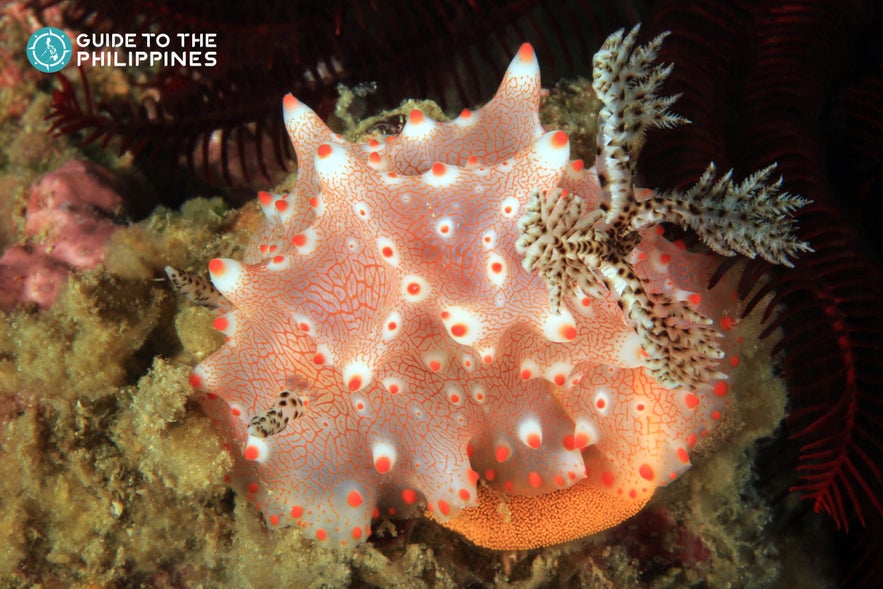
Level: All levels (Beginner to Advanced)
Best known for: Vibrant nudibranchs
Best for: Macro photography, muck diving, and blackwater diving
Batangas Province is famous not only for having some of the best beaches near Manila City but also for being one of the top spots for freediving in the Philippines. It’s especially known for scuba diving, particularly in Anilao—a coastal district celebrated as the Nudibranch Capital of the Philippines.
Nudibranchs are one of the main reasons scuba divers flock to Batangas Province. These soft-bodied sea slugs, with their neon colors and intricate patterns, are favorites among macro photographers and marine life lovers. Of the 800+ nudibranch species found worldwide, around 600 can be spotted in the Philippines—and many thrive in the vibrant reefs and dive sites in Anilao district.
Muck diving is another interesting way to find nudibranchs. Head to sites like Anilao Pier, Basura, and Secret Bay. These are prime spots for spotting well-camouflaged marine creatures. Beyond nudibranchs, keep an eye out for frogfish, sea moths, gurnards, waspfish, stonefish, stargazers, flounders, stingrays, seahorses (including the elusive pygmy seahorse), pipefish, and shrimpfish.
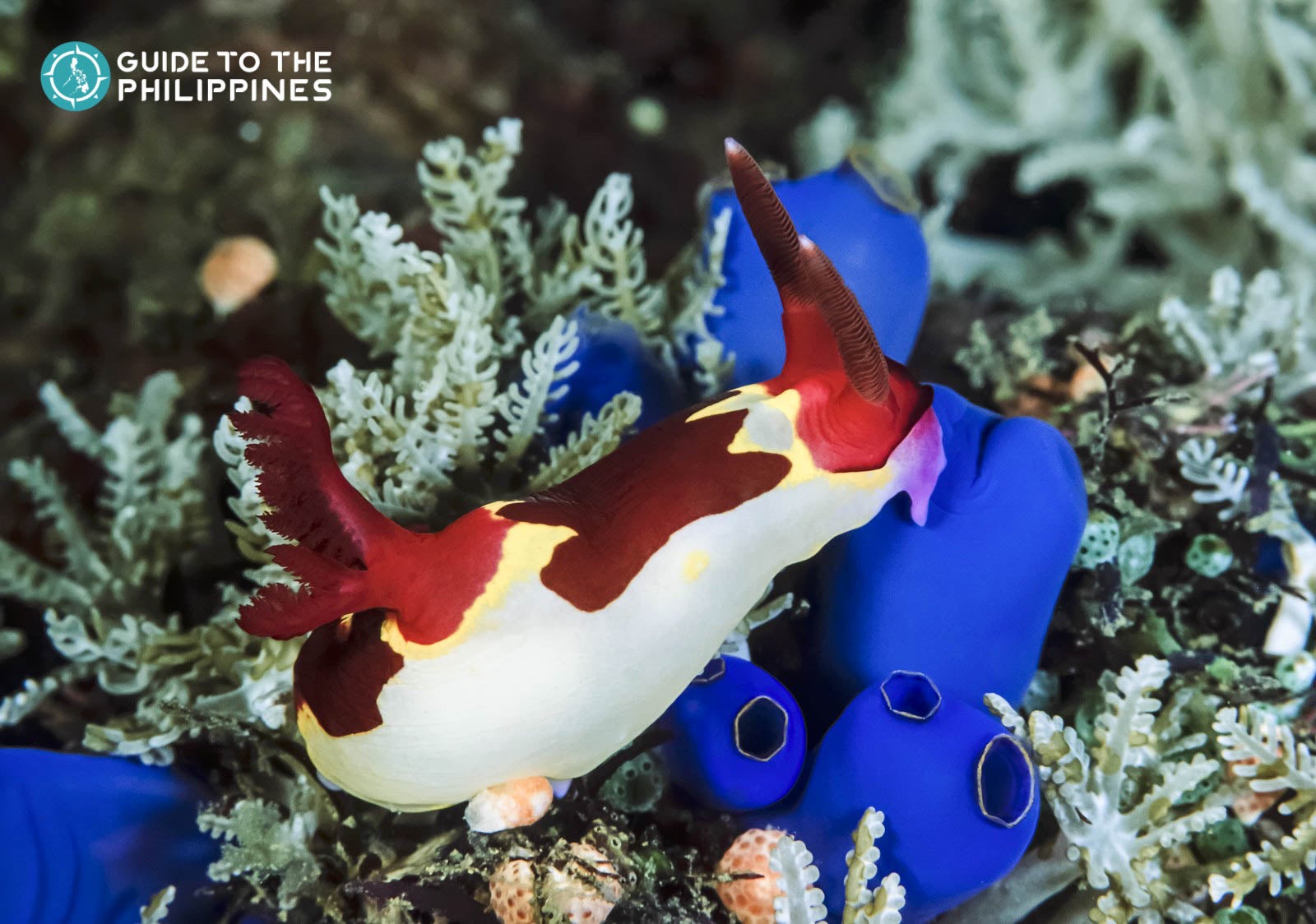
If you love swimming among schools of fish, visit Dive and Trek or Twin Rocks. You'll be surrounded by butterflyfish, angelfish, snappers, groupers, barracudas, and the occasional stingray. In some areas, clouds of anthias and fusiliers swirl around you like colorful rain underwater.
Anilao district is also one of the best places in the Philippines to try blackwater diving. This unique night dive takes you into deep open water, where lights attract rare, glowing creatures in their larval stage. It feels like floating through a starry galaxy. With calm seas and expert guides, Batangas Province offers a safe and unforgettable blackwater experience.
To make the most of your dive trip to Anilao district, check out these exciting tours. The Introductory Diving Tour in Anilao is perfect for beginners. It includes basic lessons and a guided openwater dive with a divemaster. For certified or experienced divers, the Batangas Diving Package to two Anilao dive sites is a great choice for exploring some of the area's best underwater spots.
For the ultimate dive getaway, book the ultimate 2-Day Batangas Diving Package at Altamare Dive & Leisure Resort in Anilao district. This tour package combines comfortable accommodations with guided dives at some of the best sites in Batangas Province, making it a top choice for divers looking to relax and explore vibrant marine life in one seamless experience.
- Browse the best selection of tours in Batangas Province—from diving adventures to other nature trips near Manila City!
6. Malapascua Island in Cebu Province (Best for Thresher Sharks Diving)
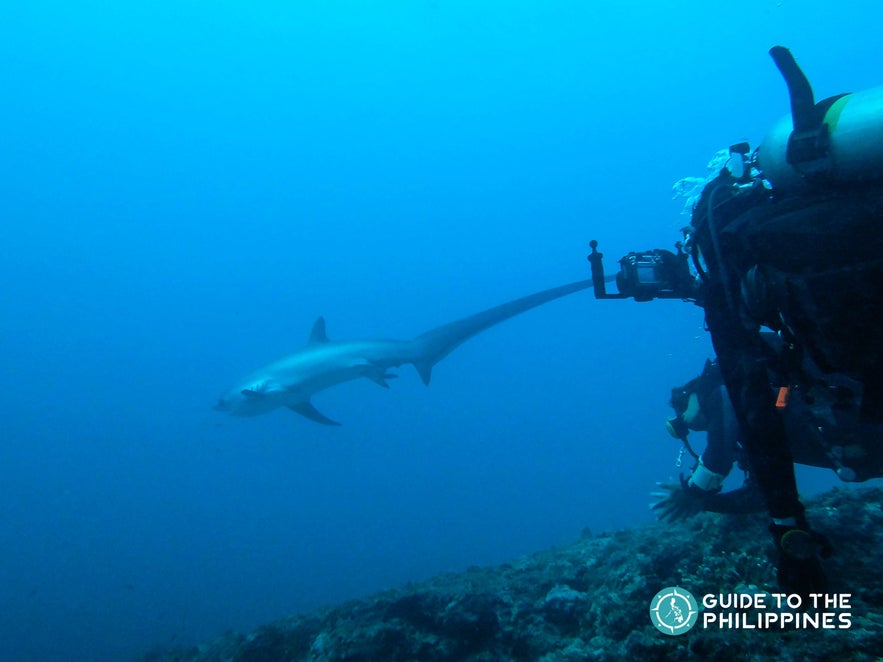
Level: Advanced
Best known for: Thresher shark sightings
Best for: Shark diving, underwater photography, deep early-morning dives
Diving is one of the top things to do in Cebu Province, and Malapascua Island offers one of the most unique marine encounters you’ll ever have. Malapascua Island, a small island off the northern coast of Cebu Province is the only place in the world where pelagic thresher sharks can be seen regularly at recreational diving depths.
With its rich marine biodiversity and the rare chance to see long-tailed, deep-sea sharks up close, Malapascua Island stands out as one of the premier diving spots in Cebu Province and the Philippines. Thresher sharks, normally found in deep ocean waters, regularly visit Monad Shoal at dawn to be cleaned by wrasses that feed on dead skin and parasites.
Thanks to this natural routine, divers have an excellent chance of spotting these elusive sharks. To witness the spectacle, set off before sunrise—usually around 4:30 AM. As daylight breaks, you'll see boats converging at Monad Shoal, all vying for the best underwater vantage points for an unforgettable close encounter.
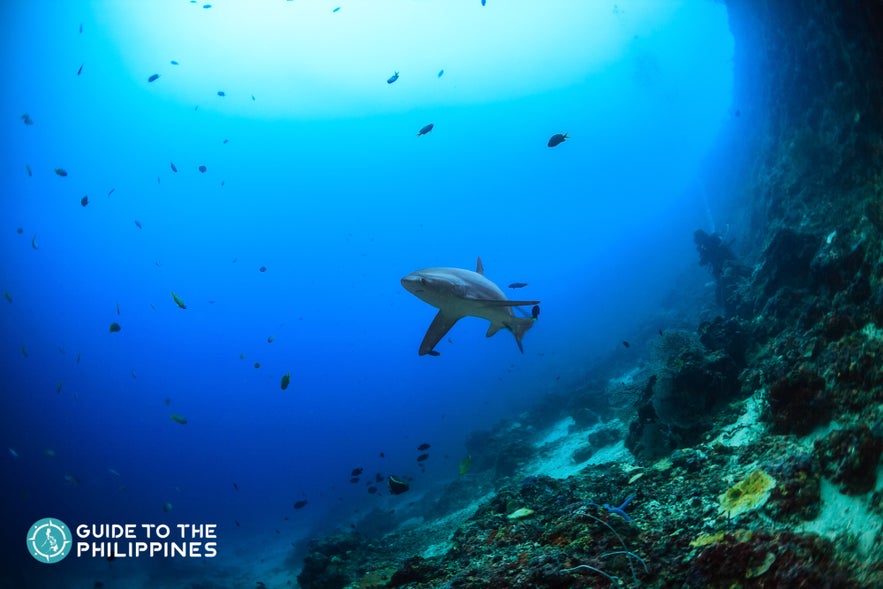
Here are a few important things to keep in mind when scuba diving to see thresher sharks in Malapascua Island:
-
The use of strobes and video lights for photography or videography is not allowed. While there’s no proven harm to the sharks’ eyes, the lights may scare them away.
-
The longer you stay underwater, the better your chances of spotting them. If you're Nitrox-certified, using Nitrox is highly recommended.
-
At the cleaning stations—areas where cleaner wrasses gather—there are pre-installed ropes marking boundaries. Divers are encouraged to kneel, hover low, or do a fin pivot outside these areas. Dive guides will closely monitor all divers to ensure these rules are followed.
-
In addition to thresher sharks, you may also spot white-tip and grey reef sharks, pelagic manta rays, and devil rays. These marine animals are also believed to benefit from the cleaning stations.
Besides Monad Shoal, the dive sites around Malapascua Island offer even more to explore. Gato Island, a protected marine sanctuary famous for its underwater tunnel, home to white-tip reef sharks. The surrounding reefs also feature sea kraits, frogfish, nudibranchs, mantis shrimp, and colorful soft coral gardens thriving on dramatic rock formations.
- Explore the best selection of Cebu Island diving packages—discover world-class dive sites and hassle-free experiences!
- Find and book the cheapest flights to Cebu Island—and start planning your trip today!
- Check out the widest selection of hotels on Cebu Island—find the perfect stay for your getaway!
5. Coron Town on Palawan Island (Shipwreck Diving Capital of the Philippines)
Video by the Philippine Department of Tourism
Level: All levels (Beginner to Advanced)
Best known for: World War II shipwreck diving
Best for: Scuba divers seeking historic wreck dives and underwater exploration in Palawan
Every time I think about diving in Coron town on Palawan Island, I think of a gallery of museums, specifically of historical interest, that transports me to World War II. At 9 AM on the 24th of September in 1944, a US Navy strike force of fighters and dive bombers arrived within the airspace of the towns of Coron and Busuanga and attacked a Japanese supply fleet of up to 24 ships.
It has always been a debate among historians whether the ships were detected from the air as moving islets or whether their radio transmissions were intercepted, which eventually led to a surprise aerial attack by the US Navy. The heavy air strike lasted less than an hour, leaving a carnage of burning and sinking ships.
The vicinity of Sangat Island in Coron town has the largest concentration of sunken ships; 11 of them lie within recreational scuba diving depths of 25 to 40 meters. The shipwrecks are in great condition and highly recommended for Advanced scuba divers. For non-divers, a reefs and wrecks snorkeling tour in Coron town can also offer a glimpse of some of these shipwrecks.

The many shipwrecks—most of which are supply ships—are among the popular attractions in Coron town. There is one warship, Akitsushima Maru, a 118-meter-long warship where a seaplane used to be deployed. It’s quite popular for wreck divers given the variety of marine life that calls it home.
Things to look out for during your diving adventures in Coron town include a three-barrelled anti-aircraft gun by the sandy area near the base of the huge crane and the crane’s intact machinery and gears. It also has a huge rip at the stern which divers can use to penetrate it.
Other interesting armaments you can see during a wreck diving tour in Coron town would include gun placements pointing to the bottom near the mast, swivel mounts for bigger guns, and an artillery shell jammed inside its mechanism. Make your way from stem to stern among endless labyrinths until you make it to the engine room where you will find its four engines.
Each shipwreck has its secret to share. Kogyo Maru, a Navy Auxiliary Cargo Supply Ship of the Imperial Japanese Navy, reveals an encrusted tractor with its recognizable metal wheels and air compressor. Irako Maru, a Refrigeration/Provision Store ship, shows special access to its galley (kitchen). Morozan Maru features her huge boilers and almost endless corridors.
If you're a beginner eager to explore these wrecks, the Discover Scuba Diving Tour in Coron town is the perfect introduction to scuba. This course covers the basics of diving and includes the guidance of a professional instructor, boat transfers, complete dive equipment, a satisfying lunch, and refreshing drinks—everything you need for an exciting dive into Coron town’s historic shipwrecks.
Where to Stay: Check out the 3-Day Diving Package in Coron Town's Tao Sangat Island Dive Resort
- Find and book the cheapest flights to Coron town—and start planning your trip today!
- Explore the best selection of Coron town vacation packages—enjoy a hassle-free trip with everything arranged for you!
- Discover the largest collection of tours in Coron town for seamless and unforgettable experiences on Palawan Island.
4. Verde Island Passage in Batangas Province (The Center of the Center of Marine Biodiversity of the World)
 Level: Advanced
Level: Advanced
Best known for: Rich marine biodiversity
Best for: Experienced divers seeking vibrant reefs, macro life, and a challenging dive in one of the most biodiverse marine ecosystems in the world
Around 400 meters off the eastern corner of the San Agapito area in Verde Island, off the coast of Batangas Province, lies Verde Island Passage—dubbed the "Center of the Center of Marine Biodiversity." Also known as the San Agapito dive site, Verde Island Passage is accessible by motorized boat from Anilao district in Batangas Province and from the town of Puerto Galera.
This world-renowned diving spot is a sight to behold. Many say the San Agapito dive site offers a glimpse of what Tubbataha Reefs National Park in Palawan Province looks like—minus the sharks and rays. Truly, exploring Verde Island Passage is one of the top things to do when in Puerto Galera town.
 The San Agapito dive site looks like a seamount with three peaks, one of which always peeks out of the water about 2 meters above the surface, depending on the tides. The third pinnacle lies 18 meters deep. The island itself sits at the heart of the Verde Island Passage, a strait covering around 1.14 million hectares. It connects the South China Sea with Tayabas Bay and the Sibuyan Sea.
The San Agapito dive site looks like a seamount with three peaks, one of which always peeks out of the water about 2 meters above the surface, depending on the tides. The third pinnacle lies 18 meters deep. The island itself sits at the heart of the Verde Island Passage, a strait covering around 1.14 million hectares. It connects the South China Sea with Tayabas Bay and the Sibuyan Sea.
The current in this part of the passage is extremely strong, so only seasoned advanced scuba divers can dive here. The direction of the current determines whether you can dive either the seamount’s east or west side.
Its wall stretches 70 meters deep. As you go down, you will find huge coral fans. There are juvenile sea turtles that simply do their round of eating, breaching, swimming, and sleeping on a periodical basis. You will also find a school of jacks and mackerels, including families of big tunas and groupers lurking around.
 The best spectacle I always look forward to seeing on this dive is the massive display of swimming red-orange-colored anthias. It's as if it was raining fish all over you!
The best spectacle I always look forward to seeing on this dive is the massive display of swimming red-orange-colored anthias. It's as if it was raining fish all over you!
The visibility can be farther than 30 meters at times, so be careful when you plan your ascent to your safety stop. It may be so clear that you think you’re within your 4-meter safety stop when you’re still 10 meters away from the surface.
When the currents are strong, it is recommended that you spend your safety stop near the closest peak and plan your ascent in the blue. Be sure to bring a long safety sausage—this area sits within one of the busiest sea lanes in the Philippines. For more tips and essential dive info about this region, check out the ultimate guide to diving in Puerto Galera town.
- Explore the best tour packages to Puerto Galera town—enjoy a stress-free trip with everything arranged for you!
- Discover the largest collection of tours in Puerto Galera town—perfect for beach lovers, divers, and adventure seekers!
3. Dauin Town Near Dumaguete City (Top Muck Diving Spot)
Video by the Philippine Department of Tourism
Level: Intermediate to Advanced
Best known for: Muck diving and rare critter sightings
Best for: Underwater macro photography and marine life enthusiasts
On the southeastern part of Negros Oriental Province near Dumaguete City is a small coastal town called Dauin. It is accessible via Sibulan Airport, also called Dumaguete Airport. Along its shores are 18 popular dive sites that are known for muck diving in the Philippines.
If you are not familiar with muck diving, it simply means that most of the area happens to be mostly sandy. Some of the critters found when muck diving in Dumaguete City are rare. You have to be clever enough to find these hiding critters because they exhibit amazing camouflage techniques specific to this environment. The best ones happen to be very tiny and so much harder to see.
In order to have the best muck diving experience, make sure you have a local dive spotter expert with you. Macro photography makes time go faster than you think, so always check your air periodically.

The dive sites generally range from the shore sloping down to as deep as 30 meters. There are car wrecks, artificial reefs made out of vehicle tires, sandy patches, and rock formations where different species reside. These stunning diving spots are definitely one of the top attractions to see when visiting Dumaguete City.
You can find pipefishes, razorfish, frogfishes, sea horses, cuttlefish, wasp fishes, seahorses, snake eels, sea moths, dragonettes, flounders, snappers, crabs, turtles, groupers, tall garden eels, shrimps, mimic octopi, various anemone fish, white tip sharks, dog tooth tuna, nudibranchs, and flasher wrasses.
Dauin town is usually the jump-off area for the Apo Island Marine Sanctuary tour. Additionally, diving in nearby Apo Island is a great way to encounter diver-friendly sea turtles and a huge school of jacks. Once you're done diving, take time to explore more of what the region has to offer by joining other fun Dumaguete City tours.
- Find and book the cheapest flights to Dumaguete City—and start planning your trip today!
- Explore the top selection of Dumaguete City vacation packages— enjoy a hassle-free trip with everything arranged for you!
2. Balicasag Island in Bohol Province (Sea Turtles, Barracudas, and Marine Sanctuary)
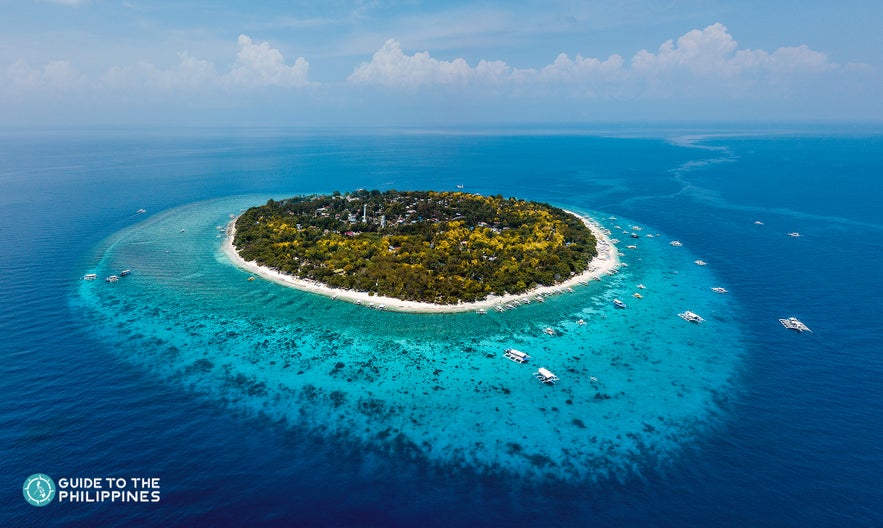
Level: All levels (Beginner to Advanced)
Best known for: Sea turtles, tornadoes of jacks, and steep wall dives
Best for: Marine life encounters, underwater photography
Diving in Balicasag Island is a must when visiting Bohol Province. You can expect vibrant coral reefs and diverse marine life, including turtles, barracudas, and even the chance to witness a tornado of jacks. As a protected marine sanctuary, Balicasag Island enforces a daily limit on divers, so it’s best to book in advance with a licensed dive operator if you plan to explore its underwater wonders.
Balicasag Island dive sites cater to all levels, from beginner to advanced. There are five beautiful diving spots around it, including the Balicasag Marine Sanctuary that highlights a 200-meter drop-off. The huge wall is teeming with marine life, together with resident tiny critters that macro diving photographers will enjoy.

Along that wall is a huge school of jacks; I remember seeing the school arranged as if it were a vertical vortex extending 30 meters long. There is also the school of barracudas. It truly is a great place to experience, especially when you get to see its visibility that could go 20 to 30 meters far, depending on the season.
On the northeast side of Balicasag Island is the Black Forest, the most popular diving site in the area. It got its name from having an abundance of amazing black corals. It features a steep slope that runs off 40 meters deep and has its share of a school of jacks and barracudas, as well as gorgonians, groupers, napoleons, tuna, wrasses, snappers, batfish, triggerfish (including the giant), surgeonfish, moorish idols, garden eels, angelfish, emperor, trumpetfish, puffers, and more.
- Explore the best Bohol Island diving packages—enjoy guided dives and a hassle-free trip with everything arranged for you!
- Find and book the cheapest flights to Bohol Island—and start planning your diving adventure today!
Turtle Point, as the name suggests, has the most number of friendly resident sea turtles you can go diving with. Do not go rushing towards one. Always make that slow approach to show that you mean no harm, and remember never to touch any of them, including any marine life.

Balicasag Island also has caves as deep as 60 to 75 meters meant for technical divers to penetrate. The other three dive sites include The Royal Garden (with an average depth of 18 meters), Diver's Haven, and the Cathedral Wall, all of which share an extensive wealth of beautiful soft and hard corals, sea turtles, and many different species of fish.
It's no surprise that Balicasag Island ranks among the top attractions in Bohol Province. Aside from diving, it's also a favorite spot for snorkeling, making it perfect even for non-divers. In fact, snorkeling is often a highlight of many Bohol island-hopping tours. You can also go on a dolphin-watching tour in Balicasag Island.
- Check out the widest selection of hotels on Bohol Island—find the perfect stay for your getaway!
- Discover the largest collection of tours on Bohol Island for seamless and unforgettable experiences on Palawan Island.
1. Tubbataha Reefs Natural Park in Palawan Province (Largest Marine Protected Area of the Philippines and a UNESCO World Heritage Site)
Video by the Philippine Department of Tourism
Level: Advanced
Best known for: Remote coral atolls, pelagic encounters, and vibrant reef biodiversity
Best for: Liveaboard diving, big fish action, and witnessing rare species in a pristine UNESCO site
Beyond its stunning beaches, Palawan Island Province is also home to one of the most extraordinary dive destinations in the world—the Tubbataha Reefs Natural Park. Located in the Sulu Sea, southwest of Puerto Princesa City, this UNESCO World Heritage Site lies at the heart of the Coral Triangle and is often considered the crown jewel of Philippine diving.
Tubbataha Reef is the largest Marine Protected Area in the country and is also listed as a Ramsar Wetland of International Importance. Diving in Tubbataha Reef offers the rare opportunity to explore over 360 species of corals—about half of the world’s total. It’s truly one of the top attractions on Palawan Island and a must-add to every diver’s bucket list.
This pristine sanctuary is also home to 23 species of sharks and rays, including whale sharks, tiger sharks, white tip, silver tip, blacktip, hammerhead, nurse sharks, manta rays, devil rays, and eagle rays. On top of that, divers can encounter over 600 species of fish, as well as 13 species of dolphins and whales in its thriving marine ecosystem.

There are only two islets in the area where 100 species of birds reside and are known to be one of the remaining safe breeding habitats for seabirds in Southeast Asia. No one is allowed to step on either islet in Tubbataha, nor are you allowed to use a drone unless you have clearance from the Tubbataha Management Office.
The word “Tubbataha” is a Samal term that means “long reef exposed at low tide.” Tubbataha Reef is home to two huge coral atolls called the North and South Atolls, plus a smaller coral structure called the Jessie Beazley Reef, found northeast of the North Atoll. Its location automatically renders itself isolated and has become its best protection against human exploitation.
Aside from being one of the UNESCO World Heritage Sites in the Philippines, Tubbataha Reef is the country’s first national marine park and has garnered milestones through the help of passionate conservationists, scientists, and scuba divers over the past decades.

Photo from the Philippines Department of Tourism
You can only visit Tubbataha Reef by liveaboard. Most dive liveaboard operations, if not all, begin their journey from Puerto Princesa City wharf by evening and arrive at Tubbataha by sunrise.
Every liveaboard set sail to Tubbataha on a weekly basis from mid-April to mid-July, when its waters are glass-flat. Outside of this window, diving trips aren’t available—so be sure to book your flights to Puerto Princesa City early and secure your spot for this once-in-a-lifetime underwater adventure.
When diving in Tubbataha, strict rules are in place to protect its pristine ecosystem. The use of gloves, reef hooks, and pointing rods is prohibited, and guests are not allowed to chase, collect, or feed marine life. Polluting, littering, and fishing are also strictly forbidden.
Keep in mind that there is no phone signal in the area, so be sure to inform your colleagues and loved ones about your trip in advance. Some liveaboards may offer limited communication via satellite phones only.
If you're dreaming of a remote, world-class dive adventure, nothing comes close to the experience of Tubbataha Reef. Book your trip to Puerto Princesa City and set sail for a liveaboard journey into the heart of the Coral Triangle—where vibrant reefs, rare marine life, and unforgettable underwater encounters await.
- Discover the largest collection of tours in Puerto Princesa City for more unforgettable experiences on Palawan Island.
- Check out the widest selection of hotels in Puerto Princesa City—find the perfect stay for your getaway!
Explore the Top Diving Destinations in the Philippines Now
 Whether you're chasing adrenaline-pumping drift dives or slow-paced macro photography, the Philippines has a spot for you. From the vibrant reefs of Balicasag Island to the thrilling depths of Tubbataha Reef in Palawan Island Province, every site promises something extraordinary. It's no wonder the country sits right in the heart of the Coral Triangle—there’s marine magic waiting at every turn.
Whether you're chasing adrenaline-pumping drift dives or slow-paced macro photography, the Philippines has a spot for you. From the vibrant reefs of Balicasag Island to the thrilling depths of Tubbataha Reef in Palawan Island Province, every site promises something extraordinary. It's no wonder the country sits right in the heart of the Coral Triangle—there’s marine magic waiting at every turn.
To make the most of your diving trip, it’s best to plan ahead. Start by exploring trips with Guide to the Philippines, where you’ll find the largest collection of guided tours, the best Philippines vacation packages, and great hotel deals online. You can also reach out via the chat widget for help customizing your itinerary and taking care of every travel detail for a hassle-free diving adventure.
With so many islands and coastal towns to choose from, diving in the Philippines is an experience you’ll want to come back to again and again. So book your Philippines scuba diving package, pack your bags, grab your logbook, and get ready—your next unforgettable underwater journey is just one dive away.
Frequently Asked Questions About the Best Dive Spots in the Philippines
Planning a dive trip in the Philippines? Whether it’s your first time diving or you're chasing your next big underwater adventure, it’s natural to have a few questions.
Below are some of the most common questions travelers ask when exploring the best dive sites in the Philippines—from the best time to visit, to where to spot sharks, turtles, and colorful reefs, plus tips on making your dive trip smooth and hassle-free.
Why is the Philippines such a top scuba diving destination?
The Philippines sits in the heart of the Coral Triangle, home to one of the world’s richest marine ecosystems. With over 2,000 fish species and hundreds of coral varieties, it offers unmatched biodiversity beneath the surface.
What’s the best time of year to dive in the Philippines?
Diving is great year-round, but the dry season from November to April brings the best visibility and calm waters. For Tubbataha Reefs Natural Park, the dive season is from mid-March to mid-June only, and it's accessible via liveaboard.
What are the top diving spots in the Philippines?
The top dive sites in the Philippines include world-famous sites like Tubbataha Reef, Malapascua Island, Balicasag Island, and Coron town for wreck diving. Other must-visit destinations are Anilao area in Batangas Province, Puerto Galera town, and the Verde Island Passage—each offering unique underwater experiences for divers of all levels.
What are some less popular diving destinations in the Philippines?
Beyond the famous spots, there are emerging diving destinations in the Philippines that offer incredible underwater experiences without the crowds.
Places like Camiguin Island, Manta Bowl and Ticao Pass in Ticao Island, Apo Reef Natural Park in Occidental Mindoro Province, Samal Island, Moalboal town on Cebu Island, and Anda town in Bohol Island feature healthy reefs, rich macro life, and relaxed diving conditions—perfect for those looking to explore hidden gems.
Can beginners dive safely in the Philippines?
Yes! Many destinations like Bohol Island, Moalboal town on Cebu Island, Anilao district in Batangas Province, and Puerto Galera town offer beginner-friendly conditions and Learn to Dive packages led by experienced dive masters—perfect for first-time divers.
Which dive sites in the Philippines are best for seeing big marine life like sharks and manta rays?
Malapascua Island is famous for daily thresher shark sightings. For manta rays, reef sharks, and other pelagics, head to Tubbataha Reefs during its short but spectacular dive season.
Where can I find the most colorful reefs, macro critters, and turtles?
Anilao district in Batangas Province is known as the Nudibranch Capital of the Philippines—ideal for macro photographers. Balicasag Island in Bohol Province offers a marine sanctuary with vibrant corals, sea turtles, and schools of barracudas.
How do diving packages simplify planning?
Diving packages, especially from Guide to the Philippines, include everything you need—accommodations, transfers, gear, and guided dives. It’s a convenient way to enjoy the experience without the stress of organizing each detail yourself.
If you need help or have special requests, you can easily reach out to Guide to the Philippines through the chat widget on the website.
Are there scuba diving packages in the Philippines that include accommodations?
Yes, many scuba diving packages in the Philippines include accommodations, along with transfers, guided dives, and gear rental. Booking a complete package is a convenient way to ensure a smooth trip, especially if you’re visiting multiple dive sites.
With Guide to the Philippines, you can even customize your package to match your travel style and schedule. Simply reach out throught the chat widget for assistance.
Should I book a diving package in the Philippines—is it worth it?
Yes, booking a diving package is definitely worth it, especially if you want a hassle-free experience. Packages often include accommodations, transfers, equipment rental, and guided dives, saving you time and effort.
When you book diving packages with Guide to the Philippines, everything is arranged for you—so you can focus on enjoying the dive, not the logistics. You can also reach out to Guide to the Philippines through the chat widget if you’d like help creating a customized dive itinerary tailored to your preferences.


